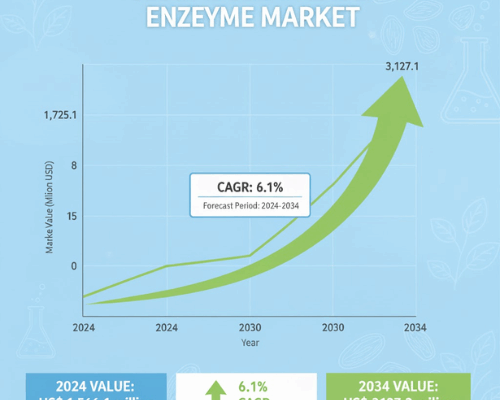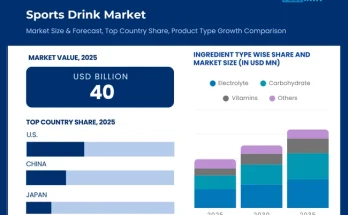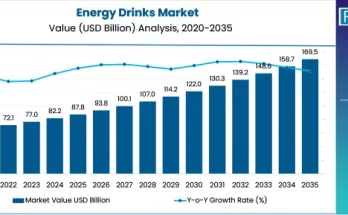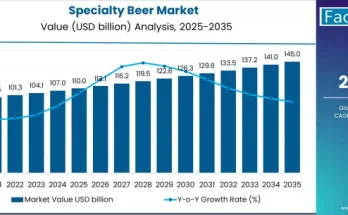The global clean label enzyme market is on a robust upward trajectory, driven by the food industry’s shift toward natural, transparent, and health-conscious ingredient solutions. According to a recent report by Fact.MR, the market is estimated to be valued at US$ 1,725.1 million in 2024 and is projected to reach US$ 3,127.1 million by 2034, expanding at a CAGR of 6.1% during the forecast period.
The market’s momentum is being fueled by the growing consumer demand for clean label products, regulatory encouragement toward natural additives, and technological breakthroughs in enzyme development. Food manufacturers are increasingly utilizing clean label enzymes to enhance texture, flavor, and shelf life while maintaining transparency in ingredient labeling.
Strategic Market Drivers
Consumer Shift Toward Clean and Natural Ingredients
Consumers worldwide are increasingly prioritizing food products that are free from synthetic additives, artificial preservatives, and genetically modified organisms. This shift is compelling manufacturers to reformulate their offerings with naturally derived enzymes, ensuring both performance and purity. Enzymes such as amylases, proteases, and lipases are gaining traction as natural processing aids in bakery, dairy, and beverage applications.
Technological Advancements in Enzyme Engineering
The rise of biotechnology and enzyme engineering is transforming the clean label enzyme landscape. Advanced fermentation and protein design technologies are enabling the development of highly efficient, non-GMO enzymes that deliver superior performance while complying with clean label standards. Companies are investing in bio-based innovations that enhance product stability, temperature tolerance, and application diversity.
Regulatory and Sustainability Alignment
Global food safety authorities and regional regulatory bodies are emphasizing transparency and sustainability in food production. This has encouraged food manufacturers to replace chemical processing aids with clean label enzymes, aligning with environmental objectives and consumer trust. Moreover, the integration of green chemistry and eco-friendly production methods is strengthening the sustainable credentials of leading enzyme producers.
Expanding Applications Across Food Segments
Clean label enzymes are witnessing widespread adoption across bakery, dairy, beverages, and confectionery sectors. In bakery, they enhance dough conditioning and texture; in dairy, they improve protein breakdown and yield; and in beverages, they optimize fermentation and clarity. The increasing use of enzymes in plant-based and gluten-free products further broadens their application scope, driving long-term market demand.
Regional Growth Highlights
Europe: Leading Through Regulatory and Consumer Advocacy
Europe dominates the clean label enzyme market, supported by stringent labeling regulations and a mature clean label movement. Countries like Germany, France, and the UK are at the forefront of natural ingredient innovation, with strong adoption in bakery and dairy manufacturing. European enzyme producers are also pioneering sustainability-driven manufacturing practices.
North America: Driven by Health Awareness and Product Reformulation
In the United States and Canada, the clean label trend is reshaping food manufacturing, driven by high consumer awareness and preference for natural products. Food processors are reformulating products to eliminate artificial additives, fueling demand for clean label enzymatic solutions. The region also benefits from strong R&D ecosystems and collaborations between biotechnology firms and food producers.
East Asia: Emerging Hub for Enzyme Innovation
China, Japan, and South Korea are emerging as key growth centers for clean label enzymes. Expanding food processing industries, evolving dietary habits, and increasing health awareness are driving market expansion. Moreover, domestic players are investing in enzyme production capabilities to meet local and export demands.
Emerging Markets: Latin America and Middle East
Rising disposable income, urbanization, and growing consumer education in Latin America and the Middle East are boosting the demand for clean label products. Governments promoting food safety and sustainable manufacturing are creating fertile ground for enzyme adoption in regional food industries.
Market Segmentation Insights
By Type
- Carbohydrases lead the segment, with significant use in bakery and beverage applications.
- Proteases are gaining traction in dairy and meat processing.
- Lipases continue to expand their footprint in the confectionery and dairy sectors.
By Application
- Bakery remains the largest application segment, followed by dairy, beverages, and confectionery.
- Rapid growth is observed in plant-based and vegan food processing, where enzymes aid in texture and flavor enhancement.
Challenges and Market Considerations
Despite its promising outlook, the clean label enzyme market faces several hurdles:
- High Production Costs: Developing natural and non-GMO enzymes involves complex processes, affecting price competitiveness.
- Limited Consumer Awareness in Developing Regions: While clean label demand is high in developed markets, emerging economies are still in early adoption phases.
- Regulatory Variability: Different clean label definitions and certification standards across regions pose compliance challenges for global producers.
- Formulation Complexity: Balancing performance with natural origin requirements can complicate product development for manufacturers.
Competitive Landscape
The global clean label enzyme market thrives on intense competition and rapid innovation. Key companies are prioritizing R&D investments, portfolio expansion, and strategic collaborations to meet evolving consumer and regulatory demands.
Key Companies Profiled:
Amano Enzymes Inc. | Kerry Inc. | Chr. Hansen Holding A/S | AB Enzymes GmbH | Advanced Enzymes Technologies | Novozymes A/S | Biocatalysts Ltd. | SternEnzym GmbH & Co. KG | BASF SE | Qingdao Vland Biotech INC
Leading players such as Amano Enzymes have been expanding their product portfolios with solutions tailored for diverse food applications, emphasizing innovation in natural formulations. Kerry Inc. continues to advance sustainability and transparency initiatives, with enzymes designed for bakery, dairy, and beverage industries. Novozymes A/S and Chr. Hansen Holding A/S maintain a strong foothold through biotechnology leadership and strategic mergers aimed at enhancing global distribution.
Future Outlook: Shaping the Next Era of Natural Food Processing
As clean label trends evolve from niche preference to mainstream demand, enzyme manufacturers are redefining the future of food processing. The integration of biotechnology, sustainability, and consumer transparency will be central to industry success over the next decade.
Manufacturers who can blend scientific precision with natural authenticity—delivering high-performing, environmentally responsible enzyme solutions—will emerge as market frontrunners. With strong R&D pipelines, strategic collaborations, and expanding global presence, leading players are poised to accelerate the clean label revolution—transforming how food is made, perceived, and consumed.



